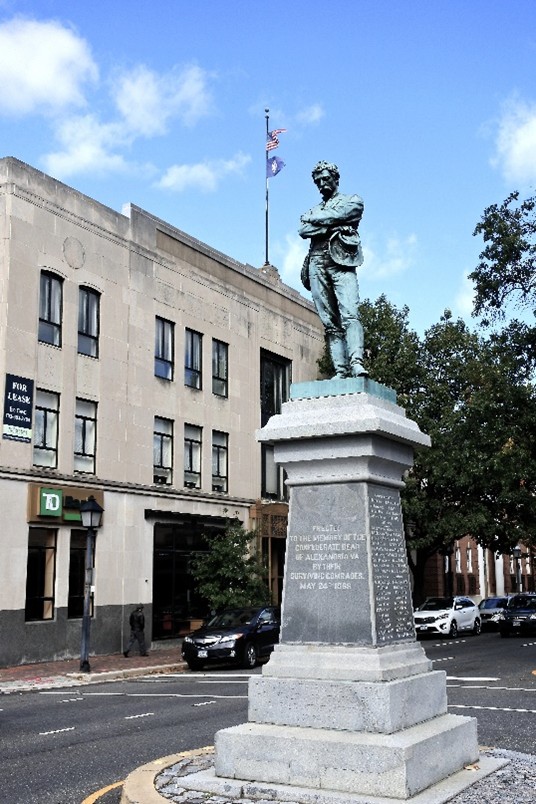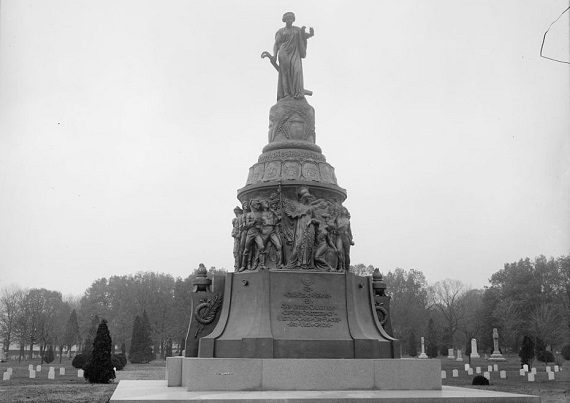The first quarter of this century has been marred by cancel culture, a consequence of an ideology pursued by reformers who call themselves “progressives,” believing themselves morally superior to others. By this ideology, each person in the world is categorized into oppressive or victim groups, largely based upon race, without regard to individuality. It is a staggeringly ignorant way to think, and Southerners, especially, have suffered from this simplistic ideology directed at them. White Southerners have been labelled as an oppressor group, without status as individuals. The Confederacy seems to be viewed as the peak period of oppression by white Southerners. Thus, any memorial to honor those who served the Confederacy must be cancelled—statues removed, names of schools and forts changed, flags denigrated, portraits removed, conversation suppressed, and so on.
One way to defend against this simplistic formula of reform was proposed by G. K. Chesterton (1874-1936), the English man of letters. In his book, The Thing, published in 1929, there is a chapter called, “The Drift from Domesticity,” in which he presents a paradox which has been called “Chesterton’s Fence,” a rule which, put simply, is, “Don’t destroy what you don’t understand.” The essay begins as follows:
In the manner of reforming things, as distinct from deforming them, there is one plain and simple principle, a principle which will probably be called a paradox. There exists in such a case a certain institution or law; let us say, for the sake of simplicity, a fence or gate erected across a road. The more modern type of reformer gaily goes up to it and says, “I don’t see the use of this; let us clear it away.” To which the more intelligent type of reformer will do well to answer: “If you don’t see the use of it, I certainly won’t let you clear it away. Go away and think. Then, when you can come back and tell me that you do see the use of it. I may allow you to destroy it.
When considering the various Confederate memorials throughout the South, it seems apparent that a vast majority of those demanding destruction do so either from a perspective outside the South or from a lack of knowledge of that period. Most reformers cannot not state the years of the war (some even, who fought whom), how many died on each side, the first and last battle, the proportion of Confederate soldiers whose families had slaves, the views on race in both North and South, the motivation to volunteer for most soldiers on both sides, the destruction delivered by the invading army, the level of poverty in the South in the ensuing decades until Pearl Harbor, who paid for the memorials in so many towns, what virtues were being honored, whether Confederate veterans had the status of U.S. veterans by law, how descendants of Confederates may wish to honor their duty and sacrifice. One simply marvels at the lack of basic knowledge of this major event in North American history. Thus, we have a circumstance in which the reformer wishes to “clear it away” without knowing why the “the thing” is there. Chesterton continues:
Some person had a reason for thinking it would be a good thing for somebody. And until we know what the reason was, we really cannot judge whether the reason was reasonable. It is extremely probable that we have over-looked some whole aspect of the question, if something set up by human beings like ourselves seems to be entirely meaningless and mysterious…But the truth is that nobody has any business to destroy a social institution until he has really seen it as a historical institution. If he knows how it arose, and what purposes it was supposed to serve, he may really be able to say that they were bad purposes, or that they have since become bad purposes, or that they are purposes which are no longer served. But if he simply stares at the thing as a senseless monstrosity that has somehow sprung up in his path, it is he and not the traditionalist who is suffering from an illusion…This principle applies to a thousand things, to trifles as well as true institutions, to convention as well as conviction.
Confederate memorials were put in place by well-meaning people for good reasons. To bring it back to the fence metaphor, as Chesterton writes, “The gate or fence did not grow there.” Let us not “clear it away” without knowing why it was put there. Let us not, as a society, conduct misguided reform which will produce unintended consequences, such as the negation of all Southern history, not just one aspect of it. The books on the South and the Confederate years have been written. The question is whether the “progressive” reformer will read them. Whether he or she will “Go away and think,” before cancelling.







The problem today is that Marxism is being institutionalized. Marxism is destruction of the institution of private property. As private property is the core of all natural and statutory rights, jt is the core institution that so many others are built upon it. Thus the refrain “long march through institutions” becomes readily blabbered by the “Critical Theorists”. I dare not call them critics. The don’t critique. They simply follow Marx’s instruction to “ruthlessly criticize everything that exists” for no other reason than to kill it because everything that “exists deserves to die”. The Provinces of North America became fertile ground in 1865 for this institutionalized destruction.
Following the theme of this article, Marxism is most worthy of being destroyed after “understanding” it.
Hundreds of thousands of 48ers were banished from Europe. They settled in the north. They brought the marxism that exists there today.
I have been reading about the Yankee “recruitment efforts” in Europe. Up to 35% of the Union army comprised these “recruits”. And, yes, the most attractive recruits were very much influenced by the Marxist Dogma of 48.
What are “48ers”. I have also seen “13.2%ers”
From Louisiana
In 1848, Europe experienced a continent-wide revolution inspired by the publication of the Communist Manifesto. Hundreds of thousands of communists were banished…they settled in the upper Midwest…and became lincolonites.
It is futile to admonish others to think who can’t and won’t think. Those who remove memorials dedicated to the memory of those they brutally conquered in the past are exercising their power and control in the present just as the Union imperialists were doing in the past. They were not thinking about the purpose or utility of the voluntary country they were destroying but only gratifying their greedy need to dictate and rule. Regrettably, rational thought and rulership rarely coincide.
“Those who learn don’t seek to rule. Those who seek to rule don’t learn.”
— Doug Casey
Karl Marx was Lincoln’s pen pal. The Pope was Jefferson Davis’s pen pal. The Communists in the Union Army were “undocumented.” Those who do not know history are doomed to repeat it.
I read Shelby Foote’s three volumes “The Civil War,” and the Kennedy twins book, “Was Jefferson Davis Right?;” and a number of other things. Jefferson Davis and the Pope communicated with each other? I don’t recall reading that that occurred.
I hope Davis didn’t communicate with the the Pope except to perhaps tell him he needed to get saved by believing in and trusting the Lord Jesus Christ exclusively. And perhaps to also tell the pope that he’s not part of any apostolic succession. The apostle Peter didn’t start anything; Peter is a part of Gods program with Israel. So, I hope Jefferson Davis didn’t communicate with the pope unless it was just to personally ambassador to the pope who did really need it.
Real Catholics have been and are “saved by believing in and trusting The Lord Jesus Christ exclusively.” Pope Pius IX communicated with both Davis and Lincoln encouraging them to work towards a peaceful end to The War. When Davis was in prison after the Yankee invaders were victorious, Pius sent him a crown of thorns to symbolize his great suffering and offered him encouragement. The crown of thorns is in the Confederate museum in New Orleans.
“Real Catholics have been and are “saved by believing in and trusting The Lord Jesus Christ exclusively.”
I hope that’s true of some Catholics’s, but there are plenty of valid reasons to question that assertion.
For example, why are they still “Catholics” and/or still attending “mass” which is, according to Catholic doctrine, the re-sacrificing of the Lord Jesus Christ? It’s absurd, and what Catholicism claim’s to do in that mass is blasphemous. Hebrews 10:12 “But this man, after he had offered one sacrifice for sins for ever, sat down on the right hand of God;”
Do these “real Catholics” have anything to do with the wafer served in the mass? Catholicism says, after the magic of transubstantiation, that the wafer becomes the literal flesh of the Saviour. Even the teenage girl Lady Jane Grey, the nine days Queen, knew that that was nonsense. Because Lady Jane Grey didn’t believe, and I, and many others, don’t believe that that wafer becomes the literal flesh of the Saviour, we are declared “Anathema.” I’m also Anathema because I believe the King James Bible is God’s words in the English language.
I was raised Catholic, went through the whole 9 yards of Catholicism; I know a little bit whereof I speak.
Again, if Davis communicated with the Pope, I hope Davis taught the Pope some things from the Bible, such as the fact that Peter was not the first pope. Peter’s ministry was to the Circumcision (Israel), and when he’s resurrected on this earth, Peter is going to be in Jerusalem judging his particular Jewish tribe (Matthew 19:28).
I reckon, Sir, that we’ll all know the Truth “some glad morning when this life is over, ” and we ” fly away….Hallelujah, by and by.” God bless you. Joyce
Marxists don’t think. Thinking requires research and evaluation. Marxists are programmed. And without conscious awareness they follow their programming no matter how delusional it is. Garbage in. Garbage out.
The same communists removed Columbus statues mostly in the northeast but also in the south. There’s an anti-Christian element to the iconoclasm. They want to eliminate Christianity in addition to the memories of our Confederate heroes.
As a young father, I tried to instill this logic to my children. It served the parallel purpose of educating these kids in the ways of our world while also trying to keep order in my own household. Wanton destruction is anathema to an enlightened society, yet extremists care little for order and seek to tear down whatever was not the work of their own hand. This was an excellent essay and I appreciate the insights it offers.
Joyce, the truth is right there in your hands. If you don’t have a Bible, get the KJB. The Lord, through Paul, says in I Tim 2:15, to “study…rightly dividing the word of truth.”
What’s “rightly dividing the word of truth? It’s understanding “time past,” “but now,” and “the ages to come.” See Ephesians chapter 2 for those important terms.
If you need or want help on this, or are curious, and hopefully you are, check out Enjoy the Bible dot com. It’s not my website, but I highly recommend it.
Correction: That’s II Timothy 2:15, Joyce.